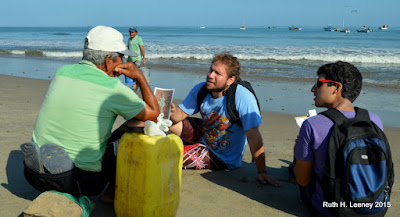Now that we are at our field base and have the “lab” set up in one of our bungalows, we are ready to start field work. With each year that I return to Madagascar to study Omura’s whales, I am never quite sure what we will find… this is because we know so little about this species, that we don’t yet know how reliably and consistently we will be able to find animals. Is this population here all year round? Do the same individuals use this habitat around Nosy Be from year to year? Do they range much farther in Madagascar than this immediate region, and will they sometimes be very far from Nosy Be?
Prior to my arrival this year, I heard numerous reports from friends and local tourist operators that there were many whales sighted in early and mid-October, in conjunction with swarms of what people referred to as “tiny shrimp”. This was very encouraging, however, they seemed to thin out right before I got here and were nearly absent during our set-up week. This made the team a bit nervous…
… and then our first day on the water proved to be momentous…
 |
| Omura's whale surfaces after feeding lunge |
Out on the water by 7:50 and within one hour we find our first Omura’s whale of the season quite close to Sakatia! These whales are relatively small, show very little of themselves at the surface, and don’t put up a prominent blow like larger whales, so can be a bit tough to find. But this first morning the sea is very calm, making it easier to find them. And as soon as we sight our first animal we see at least two others in the vicinity. We have found an aggregation!
 |
| A series of images showing side lunges |
And what’s more, they are feeding! This is fantastic because we really hoped to focus more on feeding behavior this year, particularly to document what they are feeding on. So the previous reports of “tiny shrimp” were indeed tantalizing — and it seems that the swarms of these zooplankton, what we believe to be a tropical species of krill, or euphausiids, have returned.
 |
| Plankton tow |
 |
| Close up of krill |
By the end of the nearly 10 hour day we have worked with four different Omura’s whales, done two plankton tows in the vicinity of feeding whales collecting good samples from the krill swarms, and collected a “poop” sample from the fecal plume of a nearby whale. [The right whale researchers also collect fecal samples to study a whale's reproductive and stress hormones, among other things.] Truly a remarkable first day!!
 |
| Collecting a fecal sample |
The good weather holds out for the rest of the week and we are treated to full days of work with whales, more feeding, and more plankton, and poop samples. Two major highlights to mention: First our first mother-calf pair of the season, first seen deep in the bay to the south on our second day out, and then again three days later. The mom was feeding at the surface, making several rolling lunges in which her pectoral fin and fluke came out of the water, while the calf meandered around nearby. Very mellow and tolerant, she gave us some great opportunities for underwater video to document her feeding behavior.
 |
| Omura's whale mom feeding with calf nearby |
 |
| Mom and calf surfacing |
The second exciting moment came when we recognized a whale while on the water from previous years. Upon return to base that night, a check of photos verified that this was in fact a female that we first photographed in 2012 within an aggregation of four whales, and then in 2013 with a calf, and now in 2015 again without a calf. This female clearly considers Nosy Be her home!
Finally, to close out the first week, we deploy our four SoundTrap recorders, in a relatively tight diamond-shaped cluster about 2km apart from each, outside of Sakatia. This first deployment will be for two weeks, in part to test the new units, and in part to use the close spacing as an “array” and attempt to locate singing whales through an acoustic triangulation technique.
All in all, an amazingly successful first week for a field season! An excellent start!
— Sal Cerchio

















